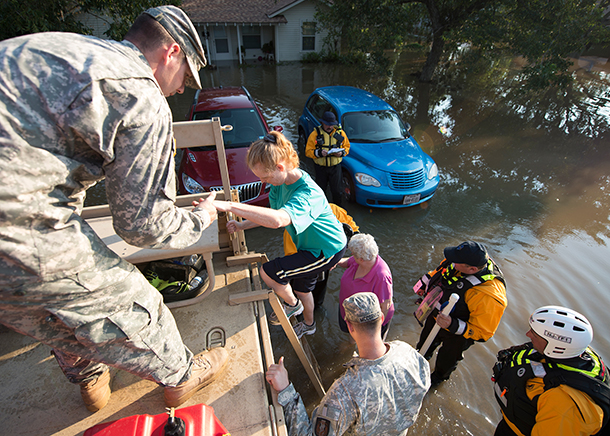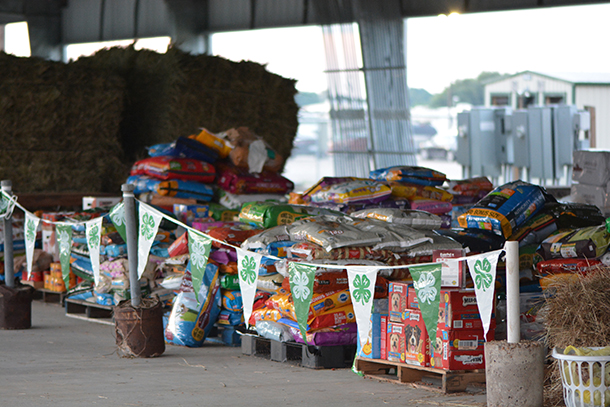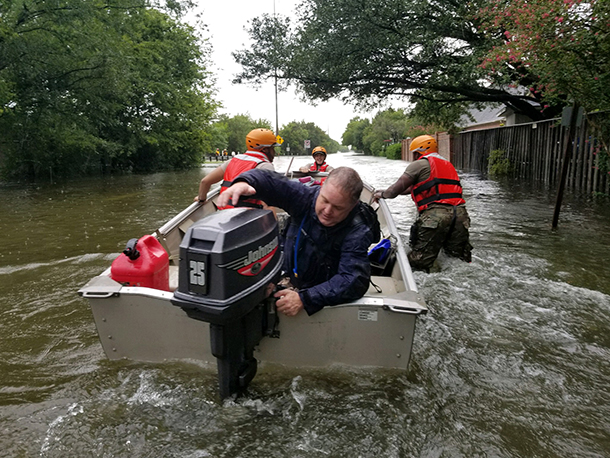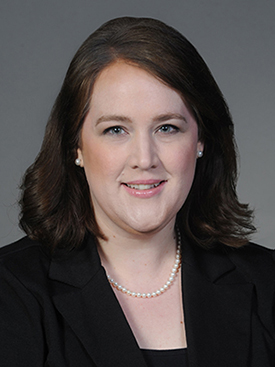Houston: Drenched, Damaged and Determined
Air Date: Week of September 1, 2017

Major storms in the Houston Metro area raise concerns about oil spills and chemical releases from the storage tanks that line the Houston ship channel, as well as numerous other petrochemical facilities throughout the region. (Photo: Petty Officer 1st Class Patrick Kelley/Released / U.S. Coast Guard, Flickr CC BY-NC-ND 2.0)
Hurricane Harvey broke records for rainfall, inundating thousands of homes and businesses and leaving tens of thousands homeless in the Houston area of Texas before it moved east through Beaumont and Port Arthur into Louisiana. Still, cleanup in Houston began as soon as the sun came out, and sodden sheetrock and carpet is piling up on curbsides. To discuss how the storm played out and how the country’s fourth-largest city can prepare for more such extreme weather events, host Steve Curwood spoke with Houston Public Media's Laurie Johnson. She notes Houston residents are resilient in the face of the public safety risks and chores of rebuilding ahead.
Transcript
CURWOOD: From PRI, and the Jennifer and Ted Stanley Studios at the University of Massachusetts Boston, this is Living on Earth. I’m Steve Curwood.
Hurricane Harvey merits extravagant language. The cyclone that first came ashore in South Texas as a Category 4 hurricane on August 25th set a rainfall record on the US continent when Harvey stalled for days over Houston, America’s fourth largest city. It dumped some 55 inches of rain that put 85 percent of the city under water, closed most businesses and schools and forced tens of thousands of people from their homes. Fortunately the death toll has been low in comparison to the destruction, thanks in large part to the remarkable generosity and help coming from the people of the Houston area themselves and thousands of emergency workers and volunteers.
Laurie Johnson, Executive Producer and Newscaster with Houston Public Media has been reporting on the city since the storm hit and joins us from her home in the northern suburbs. Welcome to the program.
JOHNSON: Thank you, Steve. Glad to be here.
CURWOOD: Yeah, I guess at this point, thouth, maybe the show should be Living on the Water for you, huh?
JOHNSON: [LAUGHS] Oh my goodness, it's been unreal to see the images of so much of Houston underwater.
CURWOOD: So, the sun is out now, but I mean, where are people now in terms of processing the damages, both emotional and physical from this storm?

State National Guard members from across the country came to the Gulf Coast to assist in the evacuation process after Hurricane Harvey hit (Photo: Senior Master Sgt. Robert Shelley / Air National Guard, Flickr CC BY 2.0)
JOHNSON: Some homes are still inaccessible, and so people are still in shelters. An estimate I heard is that as many as 100,000 people could end up homeless after this because their homes will be uninhabitable. So, as you can imagine, this is not going to be a fast turnaround. This will not be a fast recovery. The rest of the country will move on, and here in Houston we'll be dealing with this for months, if not years, to come.
CURWOOD: What insight do you have from what happened in New Orleans with Katrina with such massive flooding? Now, I'm not in Houston. You are. Looks to me that you folks are in better shape than the early aftermath of Katrina.
JOHNSON: One of the things that has set this apart was the number of locals, who, despite the fact that perhaps their own homes were flooding, got out, got boats, found ways to their neighbors, and helped each other. And what we saw with Katrina was that it was the most vulnerable. They did not have the kind of resources to be able to do that, and they were left stranded. And here in Houston, this hit everyone. This was not just poor neighborhoods, and in order to survive it, people had to help each other
.
Houston, the metro area, 650 square miles of metro area, and there's an estimate that 350 square miles are under water. That's impossible for just local police and firefighters to get to. It had to be a community effort, and that's exactly what it's been.
CURWOOD: And, of course, here we are several days on, and it's still not over. How long do folks there say it’ll take for the water to be gone, for people really to be able to get back and see what's happening?
JOHNSON: It depends on what part of the city you're in, and what watershed or reservoir you're close to. If you're on the far west side in the Katy area and in west Houston, the Addicks and Barker reservoirs. These are the reservoirs where they were worried about the dam failures, so they had to be releasing water into the neighborhoods, and they expect homes in that area to remain flooded for weeks. So, if you're unfortunate enough to be in that area, it may be weeks before you can even get to your home to see the extent of the damage.

Donations of animal food arrived at the animal shelter and supply point in Angleton, Texas after the storm. At least 1,000 animals were being cared for there as of Aug. 30, 2017. (Photo: Kathleen Phillips / Texas A&M AgriLife Extension Service, Flickr CC BY-NC-ND 2.0)
In other parts of town, it’ll drain much more quickly and people, in fact, are already cleaning up in many areas of town and ripping out carpets and sheetrock, and we're already seeing piles of garbage and debris on the curbsides waiting for pick up.
CURWOOD: And, by the way, how is your radio station KUHF? How are you guys doing? How much flooding did you experience?
JOHNSON: Well, thankfully we did not get any water in our building, but the entire building was surrounded by high water. So, for days we had a team a ride-out team in the building and they were on their own, and they had to do everything. The rest of us who were out in the community couldn't get to them, couldn't navigate the roads, and now that the freeways are clear, we can now get in and relieve them and let them get some rest and take over. But, yes, the station is based at the University of Houston, and much of the campus was underwater.
CURWOOD: I know it's early in in this recovery phase, but what's being said about what could be done to make things different in the future because it's, now, not a matter of if you'll have this again, it's when you have this again.
JOHNSON: You know, first thing I want to say is that no city in this country could have gone through 55 inches of rain in a few days without massive flooding. A lot of people have been pointing to Houston and saying, “Oh this is because of rampant unchecked development” or, “They should have known, they had Hurricane Ike, they had Tropical Storm Allison”. Well, there's nothing you could do with that much rainfall in that short a time, but there are things that we can do to improve, and there are things we can do to perhaps change our building codes in the future.
There are things that will have to be done for the infrastructure, for instance, the dams. The Army Corps of Engineers has labeled two of our dams in this region among the most unsafe in the country, but I am confident that Houston will, will make changes. I do believe that Houston is a city that learns from its mistakes, and is very innovative, and so I think that we will move forward and make changes.
CURWOOD: What efforts do you think that the city, the county, the region will make to help those people get back on their feet again? They're not just poor people. As you say, this hit all income ranges, so people who are probably pretty affluent and running their businesses or their shops or adding value economically to the region. If they're wiped out, they're not going to be able to move forward.

Laurie Johnson of KUHF estimates that 100,000 Houstonians could be homeless in the aftermath of Harvey. (Photo: Lt. Zachary West, 100th MPAD, Flickr CC BY 2.0)
JOHNSON: I think there are some things that we learned in the aftermath of Hurricane Katrina when we absorbed 200,000 people from New Orleans and Louisiana, and we got those people into temporary housing. We got those people into the local schools, and many, many, many of them stayed because they found that Houston was prosperous and welcoming. I think we will have learned some things from that.
One thing that they did during Katrina was, instead of waiting for FEMA assistance to get everybody into temporary housing, the city of Houston issued vouchers and put people into vacant apartments, and it was cheaper than what the federal assistance would have cost. So, things like that. There will be strategies that I think we'll be looking into on how to recover quickly and get the city back up and running.
CURWOOD: And maybe New Orleans will help.
JOHNSON: You know, we've heard so many stories of people coming here from Louisiana just to help with the rescue, and so many of them said to us, you know, they were here because of what we had done for them during Katrina, and they came with boats. They called it the “Cajun Navy,” and they arrived here and rescued people for days. But it is going to take a long time, and there's going to be businesses that go out of business. They will not be able to come back, and there will be people that will move away.
CURWOOD: Now, Mayor Sylvester Turner chose not to call for a mandatory evacuation, when it was clear that there was going to be a lot of rain. Tell me why he made that decision and who has reacted favorably or critically to that call.

Laurie Johnson is an Executive Producer and Newscaster with KUHF – Houston Public Media. (Photo: Houston Public Media)
JOHNSON: You know, there's been a lot of criticism of that, but we have seen here in Houston what has happened in the past when widespread evacuations have been called. What ends up happening is, when they call these evacuations for large areas, everybody evacuates, whether they're in the evacuation zone or not. Everyone sort of panics. And we use Houston as sort of a catch all, but really what we're talking about is almost a 13 county region with about eight million people. If you get even just half of those four million people trying to evacuate at one time, you are looking at complete and utter gridlock on the roads, and that's what we saw when Hurricane Rita was heading toward Houston. This was just a few weeks after Katrina hit, and Rita was coming toward us and people were panicking and deciding to get out of town, and they were stuck on the freeways for 24 hours. A hundred people died because of heat stroke and dehydration because they couldn't get water. They couldn't get gasoline. They were stranded.
We would have the same thing. We would have millions of people on the roads but instead of dying of heat stroke. They would have drowned because our freeways were completely flooded, so I think that the mayor absolutely made the right decision. He knew that we would have, instead of a mass evacuation, we would have mass casualties if people tried to get out.
CURWOOD: So what is the risk from chemical spills at this point? What's being said, what's being reported?
JOHNSON: There has not been a whole lot on this particular issue in this scenario with Harvey. You know, Hurricane Harvey hit much further south of us in the Corpus Christi-Rockport area, bringing high winds and structural damage. That's not what we got here in Houston. This was rising water, and so there hasn't been as much concern about the integrity of the petrochemical industry here.
There has been some talk about the possibility of some underground, or should I say “underwater,” pipelines being compromised, specifically with the San Jacinto River, which runs through northeast Houston and has pipelines running underneath its bed. So there's been concern there, but other than that there hasn't been a whole lot of concern about what might happen with the refineries because they are equipped for this kind of thing. The big concern is, when we have a Hurricane Ike type situation with intensive winds and structural damage.
CURWOOD: Well, Laurie Johnson, thanks so much for taking the time. Despite all that's going on, you still sound, well, optimistic looking forward.
JOHNSON: That is the heart of Houston. We are an optimistic city, and we believe deep down that we can do whatever is asked of us. So, absolutely I'm optimistic and I know we will get through this, and we really appreciate you and everyone across the country, all the thoughts and prayers and help that has been sent our way.
CURWOOD: Laurie Johnson is a Newscaster and Executive Producer with Houston Public Media, that's KUHF 88.7. Thanks so much for taking the time with me today.
JOHNSON: Thank you, Steve.
Links
Living on Earth wants to hear from you!
Living on Earth
62 Calef Highway, Suite 212
Lee, NH 03861
Telephone: 617-287-4121
E-mail: comments@loe.org
Newsletter [Click here]
Donate to Living on Earth!
Living on Earth is an independent media program and relies entirely on contributions from listeners and institutions supporting public service. Please donate now to preserve an independent environmental voice.
NewsletterLiving on Earth offers a weekly delivery of the show's rundown to your mailbox. Sign up for our newsletter today!
 Sailors For The Sea: Be the change you want to sea.
Sailors For The Sea: Be the change you want to sea.
 The Grantham Foundation for the Protection of the Environment: Committed to protecting and improving the health of the global environment.
The Grantham Foundation for the Protection of the Environment: Committed to protecting and improving the health of the global environment.
 Contribute to Living on Earth and receive, as our gift to you, an archival print of one of Mark Seth Lender's extraordinary wildlife photographs. Follow the link to see Mark's current collection of photographs.
Contribute to Living on Earth and receive, as our gift to you, an archival print of one of Mark Seth Lender's extraordinary wildlife photographs. Follow the link to see Mark's current collection of photographs.
 Buy a signed copy of Mark Seth Lender's book Smeagull the Seagull & support Living on Earth
Buy a signed copy of Mark Seth Lender's book Smeagull the Seagull & support Living on Earth

